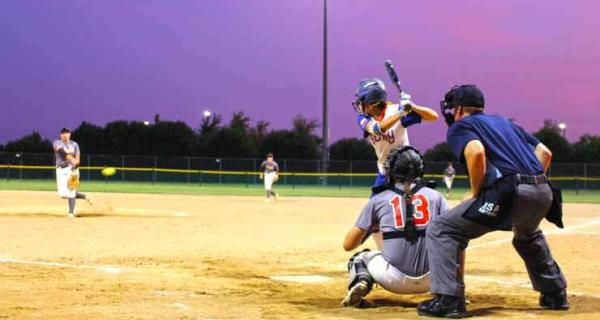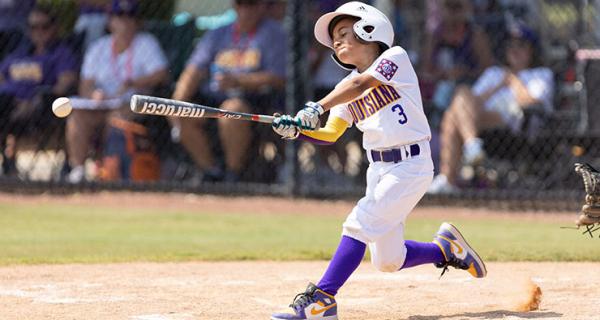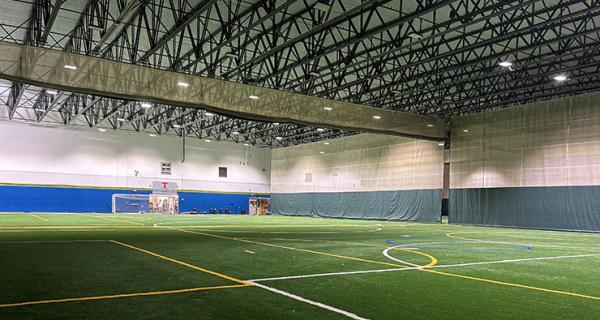What Pickleball’s Popularity Means for Tennis and Other Racket Sports
Pickleball is making a lot of noise, but the other racket sports are feeling the love from participants, too.
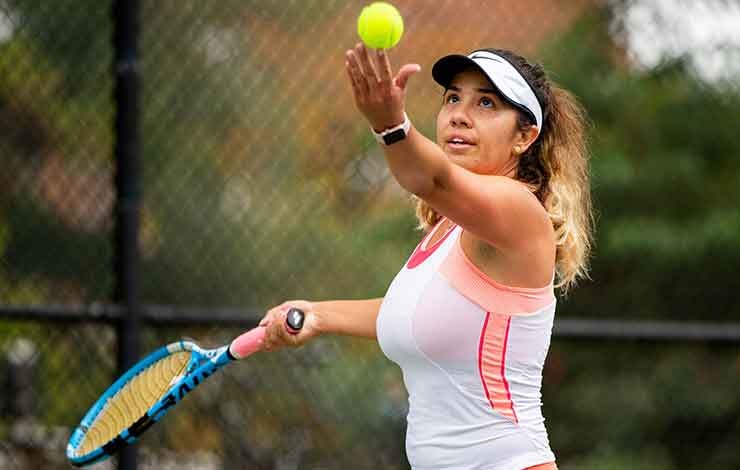
If you’ve noticed a sudden surge in conversations about pickleball, you’re not alone. This sport, once championed mostly regionally and by seniors, has exploded in popularity and now is played everywhere from public parks to professional courts.
According to the Sports & Fitness Industry Association, pickleball participation has increased by 202% in a three-year period. It’s a remarkable figure that reflects how pickleball is gaining ground in the sports arena. Even indoor malls are counting on pickleball to fill empty storefronts.
It is continuously grabbing headlines and new fans, including celebrities like Tom Brady, LeBron James, and more, who have invested in Major League Pickleball.
“Pickleball has certainly stolen the show,” says Willy Leparulo, president of the National Collegiate Table Tennis Association and an avid pickleball player himself.
What pickleball hasn’t stolen, though, is athletes playing other racket sports. Tennis, table tennis, and badminton all show increased participation as well.
The U.S. Tennis Association reports a boom not seen in decades:
- Total participation in the U.S. increased by 33% in the past three years;
- 23.6 million people play tennis in the U.S.—roughly 8% of the country’s population;
- People of color now represent 38% of the tennis-playing population, up from 32.5% in 2019.
While there is certainly competition among court time between sports—and some online ratatat on social media—the national governing bodies of racket sports show no animosity toward each other.
“There’s this perception of hate between some of these sports, which certainly doesn’t exist from our perspective,” says Craig Morris, chief executive of Community Tennis for USTA.
Throw in the numbers of badminton (up 5.6% since 2020) and table tennis (7.2% increase over three years), and the phrase “See you in court” has taken on a different meaning since the COVID-19 pandemic.
The Rise of Pickleball
Pickleball, a combination of tennis, badminton, and table tennis, is noted for its accessibility and fast learning curve. It’s a game that appeals to all ages, from children playing for the first time to seniors seeking an active lifestyle. It was invented in the 1960s but has seen explosive growth over the last few years.
In particular, three groups are most responsible for the jump:
- Amateur and semipro athletes who’ve played some form of racket sport most of their lives;
- Individuals who never played a sport previously;
- Individuals who never picked up a racket but played other sports before taking a swing at this hot trend.
Karen Parrish, director of sanctioning at USA Pickleball, belongs to the last category. She always had a strong swing—on the softball diamond. When it was time to retire her mitt, cleats, and bat, she found a new love reliant on a ball tots use prior to Little League.
Now, when she’s not keeping her feet out of the kitchen, Parrish is helping find homes for championships for the country’s fastest-growing sport.
Parrish notes the first jump came in the late 2000s among people primarily in their 40s and 50s. Now, that generation is a wee bit older and has a fair bit more company.
“There is a sense or a value of feeling like you belong to a community,” she says. “I don’t think you see that in any other sport.”
The top American player is 16-year-old Anna Leigh Waters of Delray Beach, Fla., who plays doubles with her mother. It’s common to find spouses, siblings, and different generations of families playing with and against each other on the pickleball court.
SFIA stats place the number of U.S. pickleball players at 8,949 in 2022—a number likely to surge because of individuals like Noah Suemnick, a recent college graduate who is the founder and CEO of the National Collegiate Pickleball Association.
A soccer and tennis player growing up, Suemnick caught the pickleball bug like many during the pandemic. In attempting to attract teams from 50 U.S. universities to his inaugural pickleball championship in March 2024 in San Diego, Suemnick is attempting to fill a need within the growing phenomenon.
Regulations and red tape prevent the NCAA from adopting rising sports like pickleball quickly, which has put the emphasis on grassroots efforts to grow the game.
“Pickleball has just started getting hot. I figured it’s now or never to kind of get in on this,” Suemnick says.
The Impact on Tennis
The impact of pickleball’s rise on tennis has been a topic of discussion among sports enthusiasts. Some argue that the increased popularity of pickleball could be siphoning off potential tennis players, especially among the older demographic who find pickleball’s shorter games and smaller court more manageable.
However, it’s also possible that pickleball might be introducing people to racket sports in general, leading them to explore tennis later on. The fundamental skills developed in pickleball, such as hand-eye coordination, strategic play, and quick reflexes, can be beneficial for those transitioning to tennis. In fact, some tennis clubs have started offering pickleball as a steppingstone to tennis, fostering a more symbiotic relationship between the two sports.
What’s known is tennis, buoyed by its long history and traditions, is still king and queen of the court in terms of participation. And no other racket sport draws as big of a crowd in person or on TV for major events. Parrish, for instance, freely admits to watching Wimbledon on one television and a pickleball event on another screen. The upcoming US Open in New York City is another major opportunity to market the game across different generations.
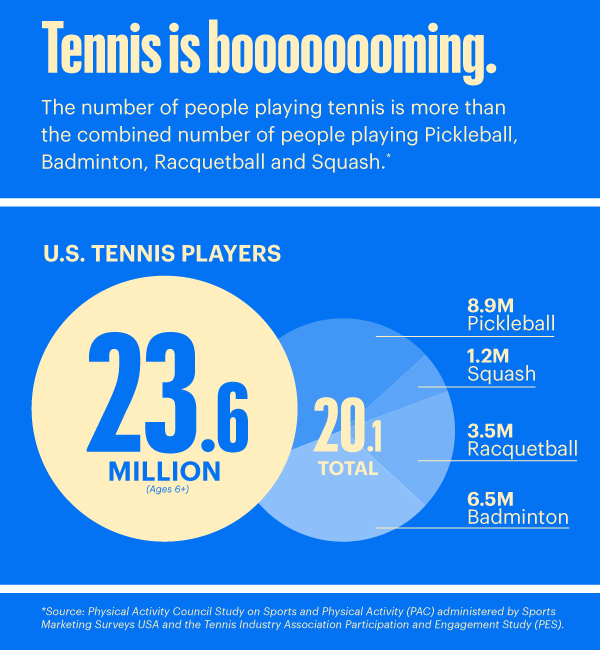
Morris says the international nature of tennis, as evidenced by majors like Wimbledon and the Open championships, sets it apart from most sports—and in league with soccer. Such appeal has offset the new absence of the Williams sisters and prolonged struggles for the American men to reach the heights of Pete Sampras, Andre Agassi, and others.
“Fans have their favorite players and some of those players are not necessarily from their home countries,” says the Australian-born Morris. “We are a global sport. We should embrace that.”
Maintaining this golden era of tennis relies upon providing the right tools for coaches—from parents to local levels to national—to fully engage athletes. To that end, USTA’s Tennis Venue Services team has awarded more than $16 million in grants, impacting more than 42,000 tennis courts and more than $586 million of infrastructure development since 2005.
Indeed, the USTA does not fear the rise in pickleball players but is adamant about maintaining its facilities. “We don’t want to lose tennis courts,” says Morris.
The NGB issued a statement of guidance advising local facilities and tennis providers on how to best utilize their space, while also accommodating pickleball and other sports. Options suggested:
- The preferred solution is separate facilities for both sports to avoid confrontations seen in some cases over the use of courts;
- Finding nontraditional sites such as granite slabs;
- Creating blended courts with pickleball boundaries inside the larger tennis area.
It should be noted USTA’s main campus in Orlando includes pickleball courts.
Lessons From Pickleball
Table tennis and pickleball share similarities due to their smaller court size and faster pace. Some table tennis players have transitioned to pickleball, drawn by the sport’s social nature and the opportunity to play outside. However, table tennis remains a strong player in the sports scene, with its popularity fueled by its indoor accessibility, inexpensive equipment, and status as an Olympic sport.
Leparulo says the sport could take a page from pickleball’s book by returning to its roots. Pingpong is the recreational version of table tennis that millions of Americans of all ages continue to play. Sales remain strong in pingpong tables and paddles, and corporate groups have taken to competitions. That recreational component—with participants playing for the love of the game—could be a catalyst to unlock the potential of table tennis.
“I’m a big table tennis fanatic and I wonder why table tennis hasn’t exploded,” Leparulo admits. “The future of table tennis is developing. It’s on the right rate track. We’re not at the pickleball level, certainly. But I think we’re going to get there soon enough.”
Morris takes pride in the adaptations in tennis. Wheelchair tennis, for example, has grown to more than a dozen college programs. There are also variations emerging to speed up the game, including playing fewer games per set, setting time limits, and doing away with deuce (in-game tiebreakers).
Such initiatives combat the perception seen from epic, five-set matches during majors that it takes hours to play tennis.
“We’re the first to appreciate that time is a commodity,” says Morris.

The Future of Racket Sports
The rise of pickleball signals a growing interest in racket sports as a whole. More than threatening the dominance of tennis, table tennis, or other racket sports, it appears to be encouraging more participation and creating a broader community of racket sports enthusiasts.
This trend suggests a bright future for all racket sports. As the public’s interest continues to diversify, sports clubs and organizations can seize the opportunity to cross-promote and introduce newcomers to a variety of games.
Leparulo says sports like tennis and his beloved tennis table would be wise to embrace the surge of pickleball popularity not as competition, but as a chance to expand the love of racket sports to more people.
“The bottom line is you want to try and partner with what’s trending,” he says. “You don’t want to go against them because they’ll crush you.”
Photo Credits: Dave Dellinger/USTA; Mike Lawrence/USTA





